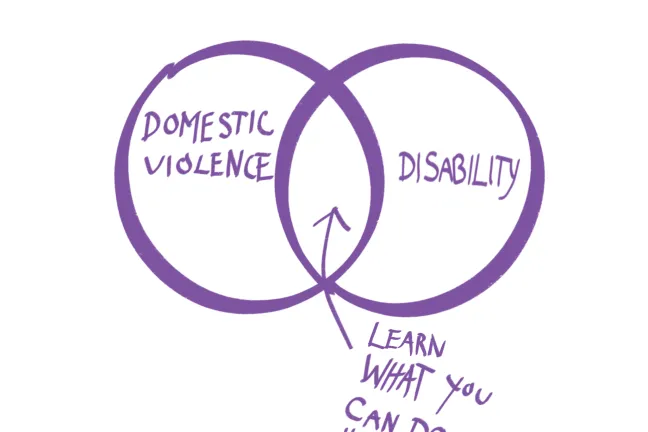This is the third in a series of weekly articles throughout October to share information on domestic violence and our work in the County to address it. Read the first article and second article. Visit our blog or follow us on Twitter and Facebook for updates.
Did you know that people with disabilities are three times more likely to experience abuse that people without disabilities? This sad and often startling fact illuminates the plight people with disabilities may face trying to live a life free from abuse, neglect, and exploitation. But there are steps we can take as individuals and as a society to act.
What we mean by "disability"
Often we say that disability is the only marginalized group someone can enter at any time. Disability may be present at birth, be developed over the course of one’s life, be the result of an accident or injury, or appear in later life as one ages.
The term "disability" is broad and often includes:
- Issues with seeing or hearing
- Need to use a mobility device
- Traumatic brain injury
- Autism spectrum disorders
- Chronic pain or illness
- Schizophrenia
- Down Syndrome
- Bipolar Disorder
- Paralysis
- Scent sensitivity
- Anxiety
- Loss of a limb
- Cancer
- Attention Deficit
- Hyperactivity Disorder (ADHD)
- Depression
As you consider the breadth of the term disability, it may begin to hit home that people with disabilities are the largest marginalized group in our country, with estimates that roughly one in five people, or 19 percent of our population has some form of disability (census.gov).
Impacting public structures to address these issues
As Multnomah County focuses on Domestic Violence Awareness month, staff want to draw attention to the unfortunate reality that the service system set-up to work with people being abused has not historically been accessible to people with disabilities. Emergency shelters have stairs, or bunk beds, or kitchens with high countertops. Services have excluded people with care needs thinking they would create a burden or liability. Even the most trauma-informed services are not set-up to accommodate non-verbal individuals or those with severe and persistent mental illness.
And yet, as we learned in the first sentence of this article, people with disabilities are more likely to experience abuse. This increased likelihood is mostly because abusive people target others with vulnerabilities. They search out people who are either unlikely to report abuse, or unlikely to be believed if they did. It is another sad reality that people with disabilities fit into both of these categories.
When an abuser targets someone with a disability, they likely exploit their vulnerabilities by directing assaults toward mobility or assistive devices (breaking glasses or hearing aids, moving walkers out of reach, etc.), or refusing to take someone to a doctor or specialist appointment. Abusers often exploit people with disabilities financially, sometimes even threatening their care if they don't sign over their disability checks. When an abuser is a caregiver, the situation becomes even more complicated, and escaping the abuse may seem impossible.
McNeff's Open Doors addresses Safely and Accessibility
In 2015 Multnomah County's Domestic and Sexual Violence Coordination Office received a federal grant to work at the intersection of disability and domestic violence. Through this funding, the disability and domestic violence fields have come together to sit at the same table and share with one another tips to increase the accessibility of domestic violence services and inject into disability services an increased focus on safety and creating safe space for disclosures of abuse.
For the past three years McNeff's Open Doors for Survivors With Disabilities has worked together to learn directly from participants in our services where our gaps are, and collectively addressed safety and accessibility in each agency and throughout our shared systems. This has been done through Safety and Access Reviews, staff training, policy review and revision, and returning to the same table month after month to share our progress and pitfalls.
One example of a success story from a Safety and Access Review occurred at The Gateway Center, our County’s drop-in domestic violence service center. The doors inside the building were extremely heavy, so much so that staff using wheelchairs couldn’t open the doors without assistance. After revealing these findings in our Safety and Access Review, we were able to sit down with County Facilities staff and determine that there was a no-cost solution to lightening the doors—simply altering a setting. Likewise, our review of the Five Oak Building revealed that while brochures were available in the lobby, they were not accessible to people using wheelchairs due to the height at which they were placed.
What you can do to help
If you are interested in what you can do to address the abuse of people with disabilities, here are some suggestions:
- Learn about living with disabilities by following disability activists on social media, watching a documentary about disability, reading articles and books written by people with disabilities.
- See people with disabilities as people, not objects or inspiration or a fate to be feared, but humans.
- Vote: people with disabilities are disproportionately likely to be affected by public policy. Consider how legislation will affect someone dependent on the system to meet their basic needs
- Raise awareness: talk to your friends and loved ones about this issue. Share articles or statistics on social media.
- Embrace intersectionality: when you are having your social justice conversations, consider how disability fits into your discussion. Have you forgotten about it? Is it an afterthought?
- Hold accessible events! Always ask if folks need accommodations. Use 24pt font on slides.
- Hire interpreters and provide electronic copies of handouts ahead of time. Ensure your facility is accessible to people with mobility devices or who cannot see.

